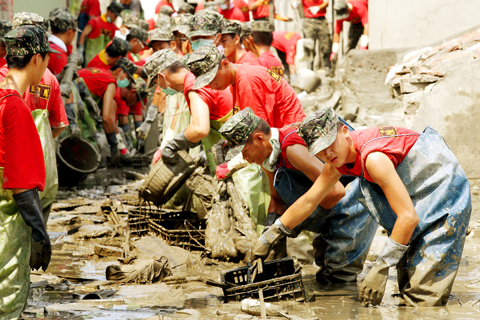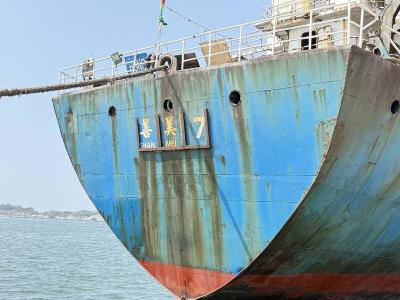Hu Nai-yuan and Shih Wen-miao received an unusual kind of cake when they celebrated their birthdays recently in Taoyuan Township (桃源), Kaohsiung County.
The “cake” — made of silt and soil — was a special request by the two paratroopers, who have been working in the devastated township as part of post-Typhoon Morakot cleanup operations. Their birthday wish, meanwhile, was that survivors could rebuild their homes quickly.
Hu, 23, and Shih, 22, were born one year apart on Aug. 23, and normally would celebrate their birthdays with parties.

PHOTO: CNA
“This is the first time I’ve spent my birthday this way. I will not forget this for the rest of my life,” Hu said.
Other servicemen may have to celebrate special occasions in disaster areas if the military makes disaster relief one its core missions, as President Ma Ying-jeou (馬英九) has suggested.
The military’s increasing participation in disaster relief operations is a given, considering Taiwan’s vulnerability to earthquakes and typhoons, and its lack of preparation for major disasters was exposed by Morakot.
But at least the performance of rank-and-file soldiers like Hu and Shih put to rest speculation that the current generation of soldiers is too soft to handle rescue tasks, such as those they faced in Taoyuan Township.
The township was one of the eight mountainous residential areas along the Southern Cross-Island Highway cut off during the storm.
As of Aug. 26, there were still 135 military officers and privates in the town, where drinking water and electricity had not yet been restored. They were working to clear rocks and mud, bathing in streams and sleeping in a damaged elementary school.
Asked whether they were tired, the two birthday boys responded, “Not at all.”
This spirit of endurance was common among the tens of thousands of soldiers who were working in typhoon-devastated zones.
In Linbian (林邊) and Jiadong (佳冬) townships in Pingtung County, hundreds of new recruits have been struggling to clean up millions of tonnes of mud and debris left behind by Morakot-triggered flooding.
“Never before in all my 20 years have I ever had to shovel stinking mud,” a new artillery recruit said.
One of his buddies agreed.
“The smell of rotting fish remains on me even after I’ve washed six times with an aromatic soap,” he said with a sigh.
Some soldiers have developed rashes while several others have sustained injuries to their hands or legs during work. But they remain undaunted and have vowed to stay in the disaster zones until the cleanup work is complete.
“As long as we can see mud, we will not leave,” they said.
Their hard work has won the hearts and minds of survivors.
“Without the armed forces’ help, I would not have been able to clear all this mess,” said one tire shop owner, surnamed Tsai, whose premises were covered with silt and mud.
Tsai said he cannot express the gratitude he feels at seeing the soldiers operating backhoes or using shovels to move head-high piles of soft sticky earth away from his house.
Yet while survivors have been unanimous in their praise of the troops’ dedication to the post-typhoon rescue and relief work, some observers have criticized the military leadership’s response in the early stages of the disaster as slow and inept.
“The Morakot disaster exposed flaws in the military’s rescue and relief operations ... The upper levels of command responded too slowly,” said Lin Chong-pin (林中斌), a military strategist who once served as deputy head of the Mainland Affairs Council and later as deputy defense minister.
In many places, he said, troops were standing by to begin the rescue and relief work, but they did not receive orders.
Other analysts have agreed that the military’s response in the first three days after the storm was a far cry from its performance over the 20 days that followed.
The military later mobilized tens of thousands of soldiers and launched roughly 400 helicopter missions per day in its rescue and relief operations. This was seen as an indication that the military has adequate post-disaster response mechanisms and capabilities.
The question is whether the military is prepared to make disaster relief one of its core missions, on a par with combat readiness.
Military authorities have argued that the criticism leveled at them was unfair.
The military set up a typhoon emergency response center on Aug. 5 and Minister of National Defense Chen Chao-min (陳肇敏) hosted a teleconference at the Hengshan Command Center in Taipei late on Aug. 6 with commanders in various operational regions.
During that meeting, Chen asked them to assist local governments in rescue and relief work by dispatching personnel or equipment as needed.
Possibly because military headquarters and regional commanders had different understandings of the minister’s order, several local governments complained about the military’s reluctance to support them in evacuation and rescue work at the height of the flooding.
Lin said the disaster was a cue for commanding officers to change their mindset and concepts and keep abreast of new trends.
The speed of the military’s disaster response and actions as well as the leadership’s relief operation command actually reflect its overall combat capability and has become a major element in evaluating the combat prowess of a country’s armed forces, Lin said.
One such evaluation was a confidential report by the Center for Intelligence Research and Analysis, a Washington-based think tank, on the rescue and relief effort by the People Liberation Army (PLA) in the wake of the Sichuan earthquake, which killed at least 68,000 people last year.
Since the Sichuan earthquake, China’s military leadership has on many occasions stressed the PLA’s role in disaster relief, Lin said, citing the report.
“The military should adjust its personnel structure, budget allocation, arsenal and equipment procurement as well as the content of training programs,” Lin said.
Meanwhile, Chen Wen-cheng (陳文政), a researcher with the New Society for Taiwan, said the military’s experiences in the Morakot relief operation were as valuable as the annual Han Kuang military exercise covering computerized war games and live-fire exercises over the past decade.
Many scenarios in the relief operation were similar to scenes simulated in Han Kuang exercises, such as troops from the north coming to the rescue of the south and the entire command and communication system being cut off.
“If the post-Morakot relief is regarded as part of the Han Kuang annual training exercise, there is ample room for improvement in the military’s C4ISR,” Chen said, referring to the command, control, communication, computer, intelligence surveillance and reconnaissance system.
There has been no armed conflict in the Taiwan Strait for half a century, but natural disasters happen nearly every year. Chen said the military should adjust its training programs to hone its disaster relief skills.
“This is a general world trend. Major countries around the world have listed disaster relief and humanitarian aid as primary missions of their armed forces,” he said.
And that will likely mean more silt and soil cakes for servicemen.

An undersea cable to Penghu County has been severed, the Ministry of Digital Affairs said today, with a Chinese-funded ship suspected of being responsible. It comes just a month after a Chinese ship was suspected of severing an undersea cable north of Keelung Harbor. The National Communications and Cyber Security Center received a report at 3:03am today from Chunghwa Telecom that the No. 3 cable from Taiwan to Penghu was severed 14.7km off the coast of Tainan, the Ministry of Digital Affairs said. The Coast Guard Administration (CGA) upon receiving a report from Chunghwa Telecom began to monitor the Togolese-flagged Hong Tai (宏泰)

EVA Air is prohibiting the use of portable chargers on board all flights starting from Saturday, while China Airlines is advising passengers not to use them, following the lead of South Korean airlines. Current regulations prohibit portable chargers and lithium batteries from check-in luggage and require them to be properly packed in carry-on baggage, EVA Air said. To improve onboard safety, portable chargers and spare lithium batteries would be prohibited from use on all fights starting on Saturday, it said. Passengers are advised to fully charge electronic devices before boarding and use the AC and USB charging outlets at their seat, it said. South

Hong Kong-based American singer-songwriter Khalil Fong (方大同) has passed away at the age of 41, Fong’s record label confirmed yesterday. “With unwavering optimism in the face of a relentless illness for five years, Khalil Fong gently and gracefully bid farewell to this world on the morning of February 21, 2025, stepping into the next realm of existence to carry forward his purpose and dreams,” Fu Music wrote on the company’s official Facebook page. “The music and graphic novels he gifted to the world remain an eternal testament to his luminous spirit, a timeless treasure for generations to come,” it said. Although Fong’s

WAR SIMULATION: The developers of the board game ‘2045’ consulted experts and analysts, and made maps based on real-life Chinese People’s Liberation Army exercises To stop invading Chinese forces seizing Taiwan, board gamer Ruth Zhong chooses the nuclear option: Dropping an atomic bomb on Taipei to secure the nation’s freedom and her victory. The Taiwanese board game 2045 is a zero-sum contest of military strategy and individual self-interest that puts players on the front lines of a simulated Chinese attack. Their battlefield game tactics would determine the theoretical future of Taiwan, which in the real world faces the constant threat of a Chinese invasion. “The most interesting part of this game is that you have to make continuous decisions based on the evolving situation,